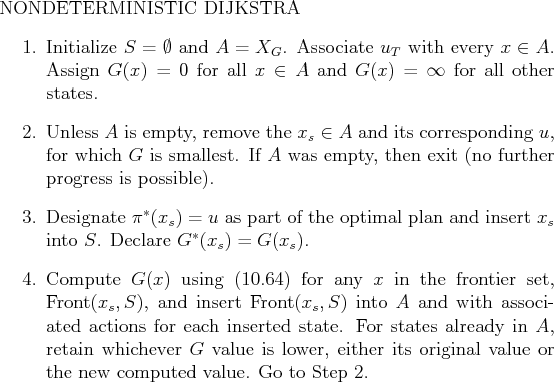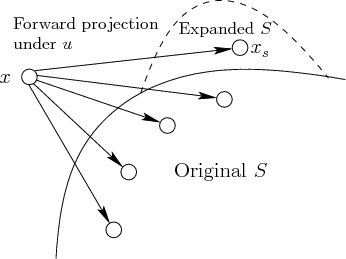
Next: Probabilistic Dijkstra Up: 10.2.3 Graph Search Methods Previous: Backward search with backprojections
Figure 10.8 shows an extension of Dijkstra's algorithm
for solving the problem of Formulation 10.1 under
nondeterministic uncertainty. It can also be considered as a variant
of the algorithm in Figure 10.6 because it grows ![]() by
using backprojections. The algorithm in Figure 10.8
represents a backward-search version of Dijkstra's algorithm;
therefore, it maintains the worst-case cost-to-go,
by
using backprojections. The algorithm in Figure 10.8
represents a backward-search version of Dijkstra's algorithm;
therefore, it maintains the worst-case cost-to-go, ![]() , which
sometimes becomes the optimal, worst-case cost-to-go,
, which
sometimes becomes the optimal, worst-case cost-to-go, ![]() .
Initially,
.
Initially, ![]() for states in the goal, and
for states in the goal, and ![]() for all others.
for all others.
 |
Step 1 performs the initialization. Step 2 selects the state in ![]() that has the smallest value. As in Dijkstra's algorithm for
deterministic problems, it is known that the cost-to-go for this state
is the smallest possible. It is therefore declared in Step 3 that
that has the smallest value. As in Dijkstra's algorithm for
deterministic problems, it is known that the cost-to-go for this state
is the smallest possible. It is therefore declared in Step 3 that
![]() , and
, and ![]() is extended to include
is extended to include
![]() .
.
 |
Step 4 updates the costs for some states and expands the active set,
![]() . Which costs could be immediately affected by the insertion of
. Which costs could be immediately affected by the insertion of
![]() into
into ![]() ? These are states
? These are states
![]() for which
there exists some
for which
there exists some
![]() that produces a one-stage forward
projection,
that produces a one-stage forward
projection,
![]() , such that: 1)
, such that: 1)
![]() and 2)
and 2)
![]() . This is
depicted in Figure 10.9. Let the set of states that
satisfy these constraints be called the frontier set, denoted by
. This is
depicted in Figure 10.9. Let the set of states that
satisfy these constraints be called the frontier set, denoted by
![]() . For each
. For each
![]() , let
, let
![]() denote the set of all actions for which the forward
projection satisfies the two previous conditions.
denote the set of all actions for which the forward
projection satisfies the two previous conditions.
The frontier set can be interpreted in terms of backprojections. The
weak backprojection
![]() yields all states that can possibly
reach
yields all states that can possibly
reach ![]() in one step. However, the cost-to-go is only finite for
states in
in one step. However, the cost-to-go is only finite for
states in
![]() (here
(here ![]() already includes
already includes ![]() ). The states in
). The states in
![]() should certainly be excluded because their optimal costs are
already known. These considerations reduce the set of candidate
frontier states to
should certainly be excluded because their optimal costs are
already known. These considerations reduce the set of candidate
frontier states to
![]() . This set is
still too large because the same action,
. This set is
still too large because the same action, ![]() , must produce a one-stage
forward projection that includes
, must produce a one-stage
forward projection that includes ![]() and is a subset of
and is a subset of ![]() .
.
The worst-case cost-to-go is computed for all
![]() as
as
Steven M LaValle 2012-04-20